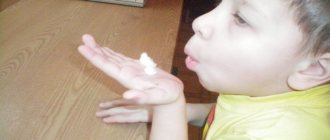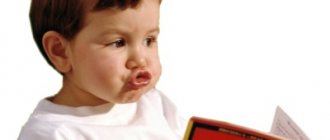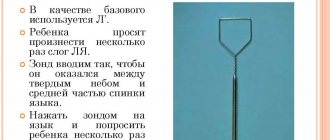Most often, when complaining about incorrect pronunciation, parents talk about their child’s inability to pronounce a particular letter. In fact, we should be talking about the pronunciation of a sound, because a letter is only a graphic representation of pronounced sounds. But in any case, there is a speech therapy problem that needs to be corrected. Quite often, children do not pronounce complex sounds, which include [sh]. However, almost any parent can teach their child to correctly pronounce the difficult letter Ш.
Pronunciation check
Parents can check the correct pronunciation of sounds by their child themselves.
There are different tests for this. You can use the same technique with which speech therapists evaluate a child’s speech at the first appointment: ask to pronounce words or syllables containing hissing sounds (for example, noise, school, came, bumblebee). To pronounce W correctly, the tongue should be like a ladle, located in the center of the oral cavity, and not stick out forward. It is important that the tip points upward.
The verification should be carried out in stages:
- The first stage is a general check. You need to ask the child to say a couple of easy sentences that contain words with a letter (for example, “you should wear a scarf in winter,” “the cat caught the mouse”). Next, you need to move on to the pronunciation of individual words (edge, hat, good, porridge);
- the second stage is checking the sound of Ш in isolation. Attention is paid to syllables. You need to ask the baby to say “OSH”, “SHA”, “OSHO”, “USHU”. This will allow you to find out how well the child can pronounce sounds. It happens that such a check reveals problems with vowel sounds. Therefore, it is recommended to vary the syllables;
- the third stage is testing in individual syllables with voiceless and voiced consonants.
To check the pronunciation of different sounds, there are special cards with bright pictures. They are sold in children's stores. Thanks to such cards, the test can be carried out in the form of an enjoyable game.
Causes
The main reason that a child cannot speak hissing sounds correctly is the way the parents communicate with the baby. Many adults deliberately copy the speech of a child, speaking to him in a childish way. Thus, the child hears the incorrect pronunciation and gets used to precisely this manner of producing the sound sh. That is why experts strongly recommend that parents speak to their children correctly.
In addition to the parental desire to imitate baby babble, some structural features of the articulatory apparatus play an important role in the production of the sound sh, which include the following points:
- tongue movement is limited due to the shortened hyoid ligament;
- articulation is affected by the size of the lips (too thin or full) and the size of the tongue (too large or small);
- dental anomalies;
- disruption of the auditory canal.
In most cases, a violation of the production of the sound w can be quite easily corrected at home with regular and careful work with the child. In some cases, children who have problems pronouncing hissing words will be helped by a speech therapist.
“Home” speech therapy sound [w]
To teach your child to pronounce [w] correctly at home, you need to learn several basic methods of production:
- mechanical;
- from a similar-sounding sound.
Mechanical setting
With this method, the baby does not need to independently search for the correct position of the sound - an adult does this for him, using special speech therapy tools (spatula, probe). If you need to put your hand into a preschooler’s mouth, it must be clean.
Mechanical staging process
Staging through sound [r]
How to learn to say the letter Ш through the sound [r]? It would seem that incorrect pronunciation of [r] is the most complex and most common speech defect. However, many children know how to pronounce [r] correctly, but do not understand at all how to position the tongue in the mouth in order to whistle and hiss correctly. For this reason, the sound should be produced through a solid [r], and not adjacent sibilants.
The preschooler should sit in front of the mirror and pronounce [r], gradually weakening the air pressure. The sound should be pronounced until the vibration completely disappears. After this, a slight hiss will be heard and [w] will sound without the auxiliary [r].
Speech therapy exercises on pronunciation of the sound [sh]
To consolidate the placed [w] in the baby’s speech, it is necessary to speak as much as possible with a separate sound - hiss during the game. For this, the preschooler is offered various exercises:
- move the snake along the path, and hiss at the same time;
- “finish” a word, for example - small ..(sh), karanda ..(sh), etc.
Articulatory gymnastics for sounds “s, z, c”
Why do you have problems pronouncing hissing sounds?
There are various reasons for incorrect pronunciation. Most often, the problem is caused by weakness of the tongue muscles - the organ, instead of rising up when pronouncing words with the letter Ш, lies at the bottom of the mouth.
Common problems with the pronunciation of hissing sounds:
- replacing Sh with T or the absence of a hissing sound in speech . For example, instead of the word “whisper” the child says “tepot”, and instead of “bear” - “mika”. This may be caused by impaired phonemic hearing or early age;
- replacing Sh with F. For example, a child says “fifka” instead of “bump.” This disorder is called labiodental sigmatism. The problem is a shortened hyoid frenulum, too active lip work, and impaired phonemic perception;
- replacing Sh with S. For example, a child says not “school”, but “skola”. This problem is called whistling sigmatism. It is caused by a violation of phonemic perception;
- lisp . It occurs if the tongue does not follow the shape of the ladle and is pushed between the lower and upper incisors, forming a gap. The air stream is scattered and weak when pronouncing hissing sounds;
- Instead of Ш, a squelching sound is heard . This problem is called lateral sigmatism. In this case, one of the corners of the lips is slightly pulled back or lowered. Sometimes the child has a slight displacement of the lower jaw to the right or left. In this case, when pronouncing the sound Ш, the air stream comes out along the edges of the tongue or goes sideways;
- Instead of Ш, snoring is heard. This disorder is called nasal sigmatism. In the presence of such a problem, the speech organs occupy a neutral position, the tongue is pulled deep into the mouth, its back is raised and connected to the soft palate, and the edges are lowered. The air stream passes through the nasal cavity. This happens when there is excessive tension on the back of the tongue.
Sibilants in a child's speech
Hissing ones include - [w], [zh], [h`], [sch`]. The formation of their correct pronunciation occurs between the third and fifth years of the baby’s life.
Incorrect pronunciation of “Sh”: types, reasons
Distortion or complete absence of sibilants in a child’s speech is called sigmatism. Depending on the type of incorrect placement, there are 4 types of sigmatism:
- Parasigmatism is a stable replacement of [sh] with another sound. Labial-dental - dental - replacement of [w] with [f]. Prizubny - replacing [w] with [t]. Hissing - replacing [w] with [sch]. Whistling - replacing [w] with [s] or [z]. Occurs with malocclusion or impaired phonemic hearing. Example: hat - slipper.
- Interdental sigmatism is the same “lisping” sound. Occurs due to a shortened frenulum or narrow soft palate.
Lesson with a specialist
- Lateral sigmatism - the sound [w] does not sound firm, as it should, but squelching, as if the baby had taken water into his mouth. Observed due to lateral open bite or weak tongue muscles.
- Nasal sigmatism - in a preschooler, the back of the tongue becomes very tense, and [w] can be pronounced with a nasal “echo.”
Before figuring out how to teach a child to pronounce the letter w, you should understand the reasons for the violation. Often a routine visit to the orthodontist, during which the bite or upper palate is corrected, ends with the long-awaited “hissing” of the baby. Otherwise, there is a need to develop the correct articulation pattern in speech therapy classes.
Articulation gymnastics for staging hissing
Before requiring the baby to pronounce a hissing sound, it is necessary to carry out preparatory articulatory gymnastics. Its duration is no more than 10 minutes. Despite the fast pace (so that the preschooler does not get bored), the child must perform each exercise carefully, since gymnastics directly determines how quickly a child can learn to say the sound [w].
Main tasks in articulatory gymnastics:
- Fence - a wide smile with teeth.
- Tube - the lips are gathered into a tube, there is a small gap between the lips.
- Alternating fence - tube.
- Hippopotamus - open your mouth wide and hold it for a while.
- Spatula - place a wide, outstretched tongue on the lower lip. You can “bite” with your tongue to make it wider.
- Homemade jam: lick the upper and then the lower lip with the tip of your tongue.
- Brush - move the tip of your tongue across the soft palate - from the throat to the teeth and back.
Articulation gymnastics
Tasks to determine the position of a sound in a word
At the beginning of the lesson, you can also develop phonemic awareness - determine the position of a sound in a word. To do this, you will need rich verbal and subject material.
- The child is asked to clap if he hears the “snake song (sound [sh]).” In this case, words are pronounced that contain the desired sound or do not contain them. You should not pronounce words with other hissing or mixed whistling sounds.
- The child is given a small sign with 3 windows indicating the beginning, middle and end of the word. And also a chip (cube/drawn sound). The teacher says the condition: “I will name the word, and you put the chip where the sound [w] is located.”
Didactic games on sound culture of speech in the senior group
Gymnastics for clear pronunciation
To correctly pronounce hissing sounds, speech therapy uses articulation and breathing exercises in combination. In this case, you should definitely remember about the correct position of the organs of articulation: lips and tongue.
Additional Information! Breathing exercises are aimed at developing smooth exhalation. To teach your child to perform breathing exercises, you need to create bright and interesting didactic material. For example, a flower with a butterfly sitting on it, which, according to the terms of the task, needs to be blown away.
Methodological basics for parents
It is important to know the correct position of the tongue and lips when pronouncing a sound in order to work on the exercises at home.
- Lips in the “tube” position;
- The tongue is wide, the tip is raised upward;
- The lateral parts of the tongue are in contact with the teeth of the upper jaw;
- A small gap forms between the palate and the tongue in the area of the upper incisors.
Articulation
The key to good pronunciation is the correct articulation of the sounds sh and zh. To teach a child to pronounce the letters sh and z correctly, it is necessary to study one method of articulation, since the speech apparatus works almost identically when pronouncing both letters. So, in order to correctly pronounce the letter w, it is necessary to work with the articulatory apparatus as follows:
- the baby's lips should be slightly pushed forward in the shape of a tube;
- the tip of the tongue is raised to the palate so that a small gap remains between them;
- the lateral edges of the child’s tongue are pressed against the upper outer teeth, giving the tongue the shape of a cup;
- a stream of air easily passes through the unused vocal cords, creating the necessary sound.
In order to understand how to teach a child to say the letter z, it is necessary to resort to the articulation described above, while connecting the vibrations of the vocal cords. Regular exercises for making sounds are very important. These exercises can be done with a speech therapist or at home.
Articulation gymnastics and its features
Before each lesson, it is necessary to sit the child down, making sure that he sits upright. All distracting objects are removed, the TV is turned off. An excellent option would be to practice in front of a mirror so that the child can see not only the articulation of the adult sitting in front of him, but also his own.
Articulation exercise in front of a mirror
- A strict sequence of exercises and regularity are the main principles that ensure the effectiveness of exercises for the speech organs. It is best to use ready-made sets of exercises that teach you to pronounce certain sounds. They are selected taking into account the age and other characteristics of the child.
- In order for the child to participate more willingly in the lesson, it is best to teach him to speak in a playful way, supplementing him with interesting riddles for the desired letter, songs, nursery rhymes and jokes
- Do not overload your child with exercises. It is better to do no more than 2-3 in one lesson, but with multiple repetitions - this makes it easier to teach the child new things.
- New exercises starting with the letter “c” can be introduced only after the child has already thoroughly mastered all the previous ones and copes with them without much effort.
- In order for the child to have the opportunity to see and correctly understand the technique of the exercises proposed to him and pronounce sounds, it is best to use a mirror for practice.
- When performing exercises, it is important to monitor the symmetry of the child’s face, the accuracy and smoothness of movements, and the correct pace. Without this, the effectiveness of the exercises will be minimized.
Lessons on making the sound “sh”
A child's education cannot be achieved without play. First you need to check your attentiveness and clarity of perception. Say words with and without the letter “sh” in any order. Invite your child to clap his hands when he hears words that contain the sound “sh”.
Be sure to praise your child for his successes.
Ask your child to use his hand to depict a hissing snake, which must follow the drawn labyrinth to the goal.
Remember together where else you can hear hissing sounds - the rustling of fallen leaves under your feet, the hiss of a cat, the rustle of a frightened mouse, the rustling of leaves in the wind.
To reinforce the sound, first use syllables and words, and then tongue twisters, children's poems and pure tongue twisters. Pictures depicting objects that have the letter “sh” in their names will be of great help in automating pronunciation.
You need to start learning the correct pronunciation of the sound “sh” with articulation exercises. Then, with the help of games and activities, you can consolidate the achieved result.
We teach a child to say the sound [Ш] quickly
An individual speech therapy session on sound production [Ш] always begins with articulation and breathing exercises. This is necessary to create a basis for correct pronunciation.
Sound production
A simple way to make the sound [Ш] is from the correct [S]. To do this, you need to take a spatula and ask the child to say “SA-SA-SA”, at which time you need to lift the tongue with the tool.
You can try to act by imitation. They bring their index finger to their lips and say: “When mom is sleeping, the baby says, “quiet, quiet shhhhh.”
After calling an isolated sound, the child is shown the “hissing goose” symbol, which will indicate a new sound.
Automation
Individual lessons on sound automation [Ш] are conducted using different materials. You can add walking games, puzzles and other interesting exercise equipment. All this will diversify the lesson.
Important! It is useful to combine automation with physical exercise. For example, with jumping or active games - leapfrog, ball and others.
The sequence of automation cannot be broken - forward syllables, reverse syllables, words, phrases, sentences, poems and tongue twisters.
Exercises for pronouncing sounds
Initially, it is recommended to prepare cards that will depict animals and objects that have problematic letters at the beginning, middle or end. You need to observe whether the pronunciation of a complex letter always turns out to be problematic, or in some positions.
pronounce the letter “Ш” using a little trick: ask the child to pronounce the letter “s”, and use a spoon to lift the baby’s tongue towards the sky. The sound will be “sh”. The letter is fixed with the words: awl, whisper, ears, noise; sentences: Our Masha rustles; and also in verse:
“Dear bear, Nice bear, Our bear is all made of plush.”
Exercises for the development of the speech apparatus
When pronouncing the sound “sh” correctly, the tongue should occupy a certain position in the mouth. It is spread wide, and the tip is raised towards the hard palate, and forms a gap with it behind the upper teeth. The lateral edges of the tongue are pressed against the upper incisors.
How to teach a child to say the letter “sh” at home - do tongue exercises with him
If the baby cannot pronounce the sound correctly, articulation gymnastics is needed. For home exercises, special exercises are used that train the speech apparatus. The child should perform them in front of the mirror to see how he can repeat what his mother shows:
- “fence” - the baby must close his teeth and show his mother what kind of “fence” he has made;
- “tube” - the child stretches his lips forward like a tube, then quickly alternates between the “tube” and “fence” exercises;
- “lazy tongue” - the tongue needs to be stuck out of the mouth and placed on the lower lip, completely relaxed;
- “bucket” - we bend the relaxed tongue up and place it behind the upper teeth, blow on it, which produces the sound “sh”.
The child does not pronounce the sound [Ш]
A group of hissing sounds steadily enters speech by the age of four. Until this time, absence or distortion is considered a conditional norm. Parents may not always notice that something is wrong.
Classes can be conducted either with a speech therapist or at home
Pronunciation assessment
Pronunciation of any sound may be incorrect. In this case, the simplest option is the absence of the sound [Ш]. Then the child’s speech will sound something like this: apka, ina, maina, etc.
Sound distortion is more common. With buccal pronunciation, the air does not pass through the tongue and lips, but goes into the cheeks. The result is a dull noise at the output. You can visually see how the child’s cheeks are puffed up.
Sometimes a child can pronounce sibilants in the “down” position. In this case, it is not the tip of the tongue that approaches the hard palate, but the middle part of its back. In this case, you get something similar to [Ш].
If the baby manages to pronounce [Ш] the back part of the tongue, which approaches the hard palate. At the exit you can hear something resembling a fricative [X] or a voiced southern Russian [G].
Important! Only a speech therapist can accurately identify the violation.
When a child learns to speak, he can replace one sound with another. Often the hissing group is replaced by whistling ones - up to four years - this is the physiological norm.
If there are problems, the preschooler begins to change [W] to [S]. In this case, instead of “hat” he says “sapka”, instead of “machine” he says “masina”.
Physiological factors
A child can be easily talked into, but he does not always pronounce all the sounds correctly. With sibilants, problems can arise due to a shortened hyoid ligament.
Sometimes problems arise due to enlarged adenoids. In this case, the preschooler has breathing problems.
In severe cases, the child cannot breathe through his nose at all and opens his mouth slightly
A baby may pronounce sounds incorrectly due to minimal brain dysfunction. In this case, there are problems with raising the tip of the tongue, and switching from pose to pose is difficult.
When to contact a speech therapist
You can work with children at home in case of mild disorders. For example, if there are no problems with the dictionary and lexico-grammatical structure of speech. In this case, parents can perform articulation and breathing exercises.
The help of a speech therapist is required in case of general speech underdevelopment and dysarthria. With such violations, there are no quick ways to correct sound pronunciation.
It is easy to identify such problems. When first diagnosed, the child has a poor vocabulary; he may connect words incorrectly and have difficulty forming words.
Articulation gymnastics for the sound R
With dysarthria, muscle innervation is disrupted. In this case, it is difficult for the preschooler to pronounce similar sounds, his breathing is weak and he has hypertonicity or hypotonicity of the muscles of the articulatory apparatus.
Important! For any problem, parents are direct participants in the correction process.
With dysarthria and general underdevelopment of speech, not only pedagogical help is needed, but also medical help.











